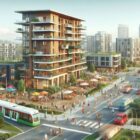Four Key Factors: Selecting Apartments Through Neighborhood Analysis

Did you know that 80% of people consider neighborhood analysis as a crucial factor when selecting an apartment?
If you’re searching for your dream rental, understanding the key factors that shape a neighborhood is essential. This article explores four vital aspects: location, safety, amenities, and transportation.
By analyzing these factors, you can make an informed decision and find an apartment that aligns perfectly with your needs and preferences.
Let’s dive into the data-driven world of neighborhood analysis!
Key Takeaways
- Proximity to work, amenities, public transportation, and schools is important for convenience and efficiency.
- Safety and security measures such as crime rates, street lighting, community engagement, and emergency services should be considered.
- Availability of amenities and services like grocery stores, restaurants, parks, healthcare facilities, and schools enhances living experience.
- Transportation options, including public transportation, walkability, bike lanes, and access to major roadways, impact commuting time and convenience.
Location
When selecting an apartment, you should prioritize the location by considering factors such as proximity to work, amenities, and transportation options. The location of an apartment can greatly impact your daily life and overall convenience. It’s important to analyze the neighborhood and gather data to make an informed decision.
Proximity to work is a crucial factor to consider. Commuting can be a significant source of stress and time consumption. By choosing an apartment close to your workplace, you can reduce travel time and increase efficiency. This can also have a positive impact on your work-life balance, allowing you more time for activities outside of work.
Amenities in the neighborhood are another important consideration. Having access to grocery stores, restaurants, parks, and other amenities can greatly enhance your quality of life. Analyzing the availability and proximity of these amenities can help you determine if the location is suitable for your needs.
Transportation options are also key. Easy access to public transportation or major highways can make your daily commute more convenient. It can also provide you with the flexibility to explore the surrounding areas and engage in activities beyond your immediate neighborhood.
Safety
To ensure your peace of mind, it’s essential to prioritize the safety of the neighborhood when selecting an apartment. Safety should be a top concern when choosing a place to live, as it directly affects your well-being and that of your loved ones. By analyzing the safety of a neighborhood, you can make an informed decision and find a secure environment to call home.
Here are five key factors to consider:
- Crime rates: Look into the crime statistics of the neighborhood, including both violent and property crimes. Check local police reports and online databases to get a clear picture of the area’s safety record.
- Lighting: Adequate street lighting is crucial for preventing crimes and enhancing personal safety. Take note of the lighting conditions in the neighborhood, especially in the areas surrounding your potential apartment.
- Community engagement: A strong sense of community and active neighborhood watch groups can contribute to a safer environment. Research if the neighborhood has any community organizations or programs in place to promote safety and security.
- Emergency services: The proximity and responsiveness of emergency services, such as police stations and fire departments, are vital in times of crisis. Consider the availability and accessibility of these services in the area.
- Safety infrastructure: Evaluate the presence of security measures like security cameras, gated access, and well-maintained public spaces. These features can deter criminal activity and contribute to a safer neighborhood.
Amenities
Consider the available amenities in the neighborhood to enhance your apartment living experience. When selecting an apartment, it’s important to evaluate the amenities offered in the surrounding area. These amenities can greatly contribute to your quality of life and overall satisfaction with your living situation.
Analyzing the amenities in a neighborhood requires an objective and data-driven approach. Start by researching the nearby grocery stores, restaurants, and entertainment options. Having convenient access to these amenities can save you time and make your day-to-day life more enjoyable. Additionally, consider the availability of parks, gyms, and recreational facilities. These amenities can promote a healthy and active lifestyle, contributing to your overall well-being.
Furthermore, it’s crucial to assess the availability of essential services such as healthcare facilities, pharmacies, and schools. Proximity to these amenities ensures easy access to necessary services and can provide a sense of security and convenience.
Taking all these factors into account will help you make an informed decision when choosing an apartment. By considering the amenities in the neighborhood, you can enhance your living experience and create a more fulfilling lifestyle.
Now that you have evaluated the available amenities, it’s time to explore the next important aspect of neighborhood analysis: transportation.
Transportation
Evaluate the transportation options available in the neighborhood to ensure convenient access to essential destinations when selecting an apartment. Transportation plays a crucial role in your daily life, as it determines how easily and efficiently you can navigate the area. Consider the following factors when assessing the transportation options in the neighborhood:
- Public Transportation: Check if there are well-connected bus or train routes near your potential apartment. Evaluate the frequency, reliability, and coverage of these services to determine whether they meet your needs.
- Walkability: Look for a neighborhood with pedestrian-friendly streets and sidewalks. Assess the proximity of essential services such as grocery stores, pharmacies, and schools. A higher walkability score indicates a more convenient and accessible neighborhood.
- Bike-Friendliness: Investigate if the area has bike lanes, bike-sharing programs, or bike-friendly infrastructure. Cycling can be a cost-effective and environmentally friendly mode of transportation, so this can be an important consideration.
- Proximity to Major Roadways: Determine the distance between the apartment and major highways or expressways. Easy access to these routes can significantly reduce commuting time and provide convenient travel options.
- Parking Availability: If you own a car or plan to rent one, assess the availability and cost of parking in the neighborhood. Consider whether there are dedicated parking spots, street parking restrictions, or parking garages nearby.
Community Engagement
Engage with the community by participating in local events and getting to know your neighbors. Community engagement is a crucial factor to consider when selecting an apartment. By actively participating in local events, you can develop a sense of belonging and establish connections with fellow residents. This not only enhances your overall living experience but also contributes to the well-being of the neighborhood.
One way to gauge community engagement is by looking at the number of local events and activities available in the area. A vibrant community often offers a wide range of events, such as festivals, farmers markets, and neighborhood gatherings. These events not only foster a sense of community but also provide opportunities for social interaction and networking.
Another aspect to consider is the level of participation from residents. Are they actively involved in neighborhood associations or community organizations? The more engaged the residents are, the stronger the sense of community is likely to be.
Getting to know your neighbors is also important for community engagement. By building relationships with those around you, you can create a supportive network and contribute to a safe and friendly environment. This can lead to a higher quality of life and a greater sense of security.
Frequently Asked Questions
What Are the Average Rental Prices for Apartments in This Neighborhood?
The average rental prices for apartments in this neighborhood are influenced by various factors such as location, amenities, and demand. It is important to consider these factors when analyzing the market.
Are There Any Nearby Parks or Green Spaces in the Neighborhood?
Yes, there are nearby parks and green spaces in the neighborhood. These areas provide opportunities for outdoor activities and a pleasant environment.
What Is the Average Commute Time to Downtown From This Neighborhood?
What’s the average commute time to downtown? It’s an important factor to consider when selecting apartments. The neighborhood’s proximity to downtown can greatly impact your daily travel time and overall convenience.
Are There Any Grocery Stores or Supermarkets Within Walking Distance of the Apartments?
Yes, there are grocery stores or supermarkets within walking distance of the apartments. This factor is important for convenience and access to fresh food. It adds value to the neighborhood.
What Is the Overall Noise Level in the Neighborhood, Particularly During Nighttime?
During nighttime, the overall noise level in the neighborhood is remarkably high. It’s important to consider this factor as it can greatly affect your quality of sleep and overall well-being.



